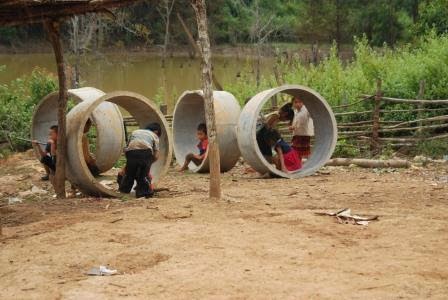 |
| Plain of Jars near Phonsavan, Laos |
The jars are the main tourist attraction in
the area. They are carved out of large blocks of stone. Yang said that there
are two theories about the creation of the jars.
1 During
the 6 century BC the blocks were dragged by elephants from a few miles away
from the quarry. The stones
were carved out to form jars using iron-age tools (you can see the striations
of the tools). They were used to make whiskey or rice wine and the iron-age
Laotians had a big party. Or many big parties.
2 As
above, but Unesco believe they were used for burial ceremonies.
Naturally the locals prefer their theory!
One of the jars at site 1 was, they believe, the first to be made out of
several stones and a mortar used to try to make it water-tight. This process
failed so they resorted to carving the centres out of blocks which are
water-tight for a year. They had lids although there was only one that we saw
that had a lid which didn’t fit because the one for which it was made had been
broken by a US bomb.
 |
| Jar Site 1 and Mr Yang |
 |
| Iron-age tools used to cut the rock |
 |
| Graham and a bomb crater |
 |
| The original jar for the lid had been destroyed by a bomb |
 |
| Jar Site 1 |
There are those who say that none of the
jars was damaged by the bombing. This is not true - they were all intact prior
to the ‘secret war’ and now there are many which are broken - some from bombing,
others from gun fire. There are many bomb craters near the jars sites, 10 -
15m wide and several metres deep. At site 1 the N Vietnamese and Pathet Lao soldiers
lived in a cave and trenches around the hill (volcanic plug?), and there are
large craters just outside the mouth of the cave and across the hill. There were
craters near all 3 sites.
If you look at Google Earth you can see bomb
craters all over the place on the Plain of Jars - mainly on hill tops. Most
hill tops also have trenches which are not so easily spotted on Google but
easily seen on the ground. The sites have been cleared of Unexloploded Ordnance (UXO) along the paths so one has to stay on the white sides of the Mines Advisory Group (MAG) marker bricks.
 |
| Keep to the white side of the Mines Advisory Group bricks |
|
 | |
| Plain of Jars |
 |
| Jar Site 1 |
 |
| Jar Site 2 |
 |
| Peter and Graham at Jar Site 3 |
 |
| Kham Valley |
 |
| Tad Lang Waterfall |
 |
| Rice Paddy After Harvesting |
 |
| Rice Paddy After Harvesting |
 |
| Kham Valley |


























































